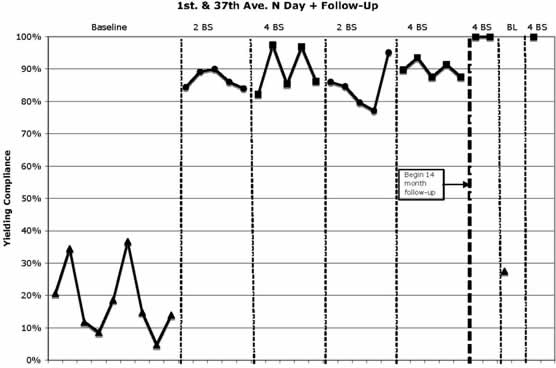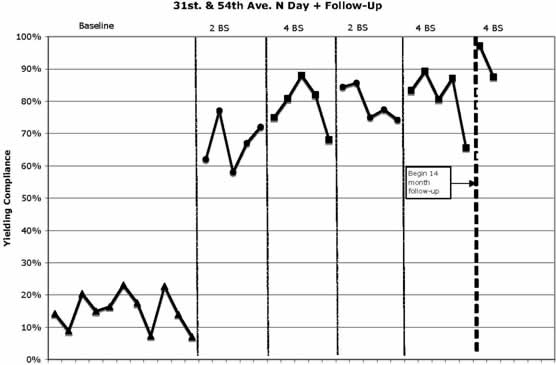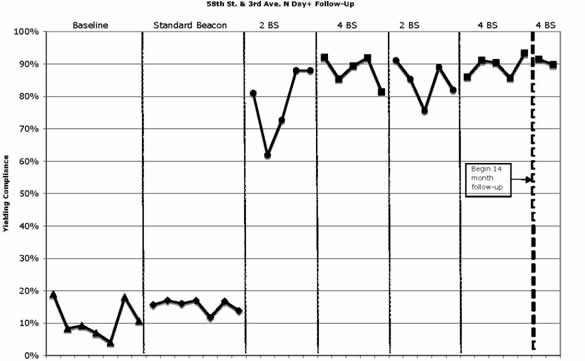 |
The percentage drivers yielding right-of-way to pedestrians during each session is presented on the next two pages in Figures 5. At the 22nd Avenue N. at the 5th St. site, the introduction of the rapid-flash beacon produced a marked increase in drivers yielding right-of-way to pedestrians from a baseline level of 28% to a two-beacon treatment level average of 84% and an average of 93% for the four-beacon treatment. Crossing 14 months latter with the beacon was associated with yielding of between 97 and 100% while crossing 14 months latter without the beacon lead to yielding of 23%.


Figure 5 - Yielding Compliance


Figure 5 - Yielding Compliance
At the 1st Street at 37th Ave site the introduction of the rapid-flash beacon produced a marked increase in drivers yielding right-of-way to pedestrians from a baseline level of 18% to averages of 86% and 90% for the two- and four-beacon treatments, respectively. Data collected 14 months later was associated with yielding of 100% with the beacon and 27% without the beacon.
At the 31st St. at 54th Ave. South site the introduction of the rapid-flash beacon produced a marked increase in drivers yielding right-of-way to pedestrians from a baseline level 15% to 73% and 80% for the two and four beacons treatments respectively. Data collected 14 months latter with the beacon was associated with 93% yielding.
At the 58th Street site the introduction of the standard overhead beacon produced a small increase in driver yielding to pedestrians from 10.9% to 15.5%. The introduction of the rapid-flash beacon at this site lead to a marked increase in yielding to 81.5% and the introduction of the four beacons system was associated with a further increase to 88.7%. Fourteen-month follow-up data at this site averaged 91%.
The majority of yielding across all four sites during each condition occurred between 30ft and 50ft intervals, which is behind the advance yield markings and signs. There were increases in yielding at >30ft. over baseline for the two and four light treatments of 8.3% and 9%, respectively. Yielding at >100ft. more than doubled over baseline for the two-beacon system and showed an even greater increase with the introduction of the four-beacon system. The absence of the standard beacon at the 58th. Street location produced a better effect on yielding distance than the standard overhead beacon. There were 48 motorists yielding at less than 30 feet during standard treatment with only 27 during baseline. These numbers are representative of 34% and 33% of the yielding for this that occurred during baseline and standard treatment conditions, respectively. There were also only one more car yielding at >100ft. during the standard beacon treatment, 8 vehicles, when compared to baseline, 7 vehicles.
During baseline across all four sites, there were a total of 48 passes or attempted passes. There were only 8 of these occurrences during treatment phases, three occurred during the two-beacon treatment and five occurrences during four-beacon treatment. It is also worth noting that at the 58th Street location there were 14 occurrences during the standard beacon treatment but only 10 of these instances recorded during baseline.
There were a total of only five occurrences of a vehicle braking hard behind another vehicle. There were two of these occurrences during the standard beacon treatment at the 58th Street location and three of these occurrences during the two-beacon treatment combined from all sites. There were no reports of hard braking during the four-beacon treatments at any location.
Data for nighttime yielding is presented in Figure 6. Baseline yielding compliance at night was 4.8% during nighttime data collection at the 1st at 37th Ave. North location. The introduction of the treatment was associated with an increase in nighttime yielding to 86.7% for the two-beacon system and 99.4% for the four-beacon system. These changes represent increases of 81.9% and 94.46% over baseline levels respectively. Nighttime yielding remained high during the 14 month follow-up.
During baseline conditions, the majority of yielding occurred at the 30ft.-50ft. range (47.1%). The same is true for the two-beacon system and four-beacon system, 31.05% and 35.9%, respectively. During baseline there was no yielding recorded at either the 70ft.-100ft. or >100ft. intervals. However, with system activation there was a large increase in yielding at, or greater than, this distance. During the two-beacon system treatment, 70% of the yielding occurred at or greater than 30 feet. Over 74% of yielding occurred at these distances during the four-beacon treatment. Additional data for this location is provided in Figure 5 on the following page. Although we only have a complete set of night data for one site we have probe data for three other sites that show similar results.
Inter-observer agreement on the occurrence of a yielding behavior averaged 92% with a range of 80% to 98%. Inter-observer agreement on yielding distance averaged 97.5%. Inter-observer agreement on evasive conflicts was 100%. Inter-observer agreement on whether the pedestrian was trapped in the center of the road averaged 100%; inter-observer agreement on vehicle passes or pass attempt averaged 100%, inter-observer agreement on vehicles that jam on brakes averaged 100%.
The results show average daytime yielding for baseline across all four sites to be 18%, two systems 78%, and four systems 88%. These represent increases of 60% more yielding over baseline for the two-system treatment and a 70% increase from baseline to the four-system treatment. A two-sample t-test for independent (uncorrelated) samples was performed to test the significance between the averages of the reported yielding percentages between the two- and four-beacon systems. The test showed significance at the .05 level (Table 1).
Figure 6. - Nighttime driver yielding compliance for 1st Street location

| T-Value | P-Value | df | |
| Obtained | |-3.68| | 0.008 | 78 |
| Critical | 2 |
The daytime combined average yielding of all four sites during baseline are as follows: 0-10ft. = 3.6%; 10ft.-20-ft.= 10.3%; 20ft.-30ft.=16.8%; 30ft.-50ft.=36.6%; 50ft.-70-ft.=14.9%; 70ft.-100ft.=10.6%; and>100ft.=7.2%. Once the two-beacon system treatments were activated, the combined average yielding per distance was: 0-10ft.= 3.1%; 10ft.-20ft.= 7%; 20ft.-30ft.=12.3%; 30ft.-50ft.= 31%; 50ft.-70ft.=17.8%; 70ft.-100ft.=13.7%; >100ft.=15.1%. The combined average yielding distance for the four-beacon was: 0-10ft.= 2.3%; 10ft.-20ft.= 6.2%; 20ft.-30ft.=13.3%; 30ft.-50ft.=31.6%; 50ft.-70ft.=18%; 70ft.-100ft.=11.6%; and >100ft.=17.1%. The total average yielding distances for all four sites (>30ft.) is provided in Table 2.
|
United States Department of Transportation - Federal Highway Administration |
||